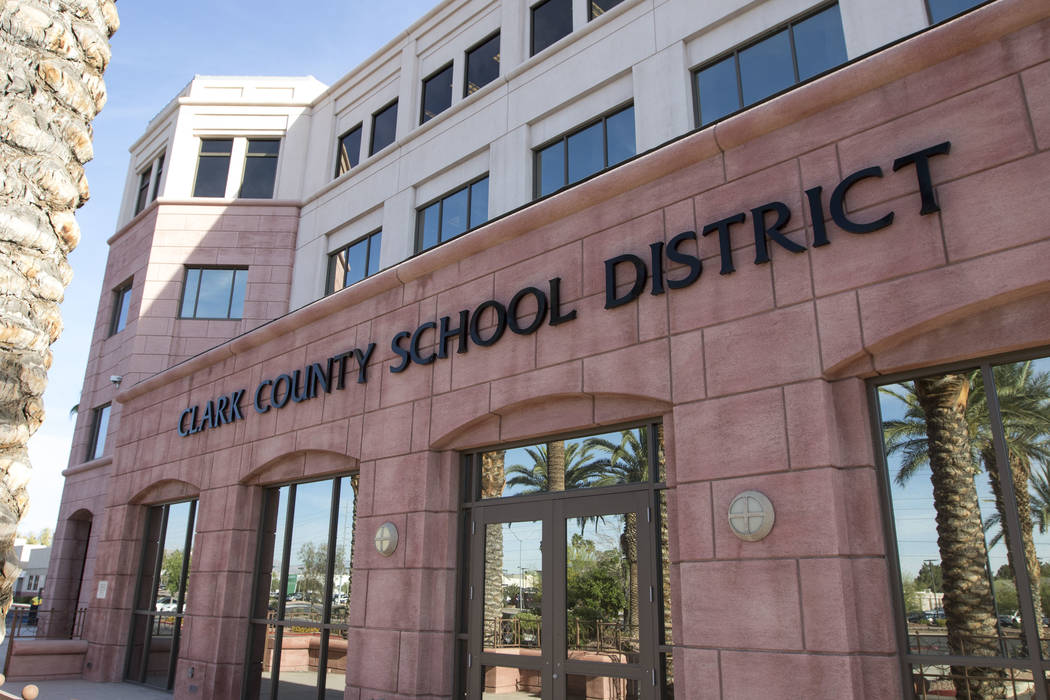CCSD officials question viability of union-run Teachers Health Trust
As negotiations continue over health care contributions for the Clark County School District’s roughly 18,000 teachers, the School Board is raising concerns about the financial health and stability of the union-managed Teachers Health Trust.
Teachers have protested the board’s proposal to switch to UnitedHealthcare, which would eliminate the health trust as the teachers’ insurance provider, and decrease its contributions to employees’ health-care coverage.
Some district officials are pushing back, saying teachers are being misled by the union. They cite concerns from teachers over higher out-of-pocket costs, unpaid claims and some doctors’ refusal to accept the trust’s insurance as evidence that the trust is failing.
“We’re seeing that it’s got a leak, and it’s slowly sinking,” Board President Deanna Wright said. “And they’re not willing to do anything to fix it.”
Meanwhile, the trust’s two top leaders, CEO Gary Earl and Chief Operating Officer Felipe Danglapin, recently left their jobs, adding to questions about the trust’s status.
The trust’s interim chief operating officer, Kim Phillips, did not respond to emailed questions. John Vellardita, executive director of the teachers union, the Clark County Education Association, also did not reply to multiple requests for comment.
Declining assets
The trust ran a deficit in five of the 10 months ending in April and suffered a $9.7 million loss in net assets over the period, a financial report shows.
That suggests it needs to change its model to survive in the long term, said Sharie Lewis, a member of the Association of School Business Officials International and former accounting and payroll director for the Portland (Oregon) Public Schools.
“Their balance sheet … won’t sustain that over a period of time,” she said.
On the other hand, she said, the $81 million in assets on hand at the end of June 2016 could enable it to ride out the losses until it gets back on its feet.
The trust was on the brink of collapse about two years ago, when it received a one-time boost of roughly $10 million from the district for 2016, which included a boost in monthly contributions from $538.87 to $583.87 per employee.
Under Earl’s leadership, the trust adopted a more fiscally conservative strategy that included higher out-of-pocket expenses or copayments for teachers. Earl said in January that the shift ended a five-year deficit and enabled the trust to begin rebuilding its financial assets.
Evidence of that has yet to appear in the trust’s financial reports, but Lewis said that strategic changes can take time to improve the bottom line for an agency of that size — possibly as long as three years.
Still, questions about a possible turnaround deepened with the departure of the trust’s leaders.
Earl, who assumed his post at the trust in March 2016, declined to comment on his departure, but he announced on Facebook in May that he had “successfully completed” his mission as the trust’s CEO. Danglapin also declined to comment.
Wright, however, said the trust is worse off than it was before last year’s financial boost. Of particular concern, she said, is the high number of unpaid claims.
The trust paid 100,000 fewer claims in 2016 than in 2015, Edward Goldman, the school district’s chief negotiator, wrote in a letter to the union in May. Based on the number of current outstanding claims, the district does not believe the trust will be sustainable in the near future, Goldman wrote.
Some teachers, however, argue that the trust’s financial problems stem from the district’s refusal to provide enough in health care contributions for years. They note that the district’s proposed monthly $538 contribution for teachers is lower than the amounts other bargaining groups received — $576 for support staff and $693 for administrators — in the 2017-2018 budget.
District officials counter that other bargaining groups receive higher contributions because they are willing to deduct that from their salaries during contract negotiations, a contention supported by Stephen Augspurger, the administrators union’s executive director.
“The teachers have not been willing to do that,” Wright said. “We have asked, we have suggested, we have even gotten to the point where we have said, ‘We want you to increase this,’ and they’ve told us, ‘You can’t tell us where we’re going to put our dollars. That’s our business.’”
Concerns over trust’s future
The School Board’s proposal to switch to UnitedHealthcare would essentially eliminate the trust, providing teachers with insurance and a network of doctors. The trust currently contracts with WellHealth to manage its medical provider network.
Although many teachers lament the higher costs and unpaid claims, some say the trust needs time to regain a firm financial footing. They see the board’s proposal as an attempt to get rid of the trust.
“I was here in the early days before the trust, when we switched providers yearly and experienced a multitude of problems trying to get our claims processed,” Tom Wellman, a retired district employee, told the School Board last month. “Those were not good times. Trying to starve the trust into submission is not the way to solve your employee shortage.”
Teachers and the union have also argued that support staff members saw a change for the worse when they switched to UnitedHealthcare.
In a statement, UnitedHealthcare said it would be willing to collaborate and apply decades of experience if asked to help solve the district’s health benefits challenges.
Contact Amelia Pak-Harvey at apak-harvey@reviewjournal.com or 702-383-4630. Follow @AmeliaPakHarvey on Twitter.






















